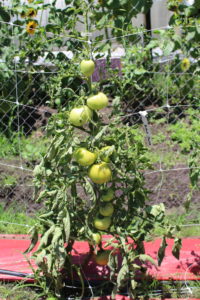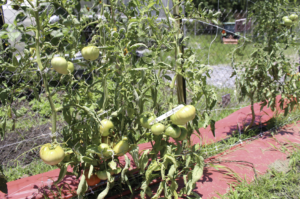Tomatoes are without a doubt, the most popular plant amongst home gardeners. There are over 5,000 different varieties of tomatoes. Tomatoes can be eaten raw, sliced, steamed, boiled, baked, roasted, and pureed into sauces. This versatility is what led to tomatoes being so popular with home gardeners along with them being so easy to grow. Tomatoes are fruits, but culinarily treated as a vegetable.
Tomatoes were first cultivated in South America by the Aztecs as a wild plant. They were slowly adopted in Europe because they thought tomatoes were poisonous. Tomato stems and leaves are poisonous, so be extra careful if you’re a pet owner when growing tomatoes.
There are three main types of tomatoes divided by how they are used. They are: Slicers, Cherries, and Paste. Slicer varieties include Beefsteak, Big Boys, and Cherokee purples. These kinds of tomatoes are typically sliced and eaten raw or cooked on top of pizza. Cherry tomatoes like Sun Gold, or Yellow Mini, are the bite-sized tomatoes that are typically seen in salad. Paste tomatoes like Romano, are commonly used when creating sauces or tomato pastes. Paste tomatoes come in a variety of different colors and are oval-shaped. All tomatoes are similar in flavor but can vary slightly by their amount of sweetness and tart. They are a great source of antioxidants, vitamin C, K, calcium, and phosphorus.
Planting Tomatoes
 Tomatoes can be grown in containers or on a trellis. Bush type tomatoes tend to be grown in containers while vine type is grown outside on a trellis. Vine type can also be grown in a container but will require the assistance of stakes or container trellises.
Tomatoes can be grown in containers or on a trellis. Bush type tomatoes tend to be grown in containers while vine type is grown outside on a trellis. Vine type can also be grown in a container but will require the assistance of stakes or container trellises.
Tomatoes need full sun, slightly acidic soil 6.0 – 6.8 pH, and a well-drained fertile soil. Tomatoes are commonly planted indoors then transplanted. Start seeds indoors 6-8 weeks before the last frost. Plant the seeds half an inch deep in starting trays. Once you have your sprouts, move them outside two weeks after the last frost and space them 36 inches apart. If you’re transplanting to a container, pots should be 18 inches deep and in diameter. Tomatoes can grow in growing zones 3-13 but prefer warmer weather. It is recommended you plant your tomatoes in containers if you live in a cooler climate this way you can bring the containers inside when the weather is too harsh. Tomatoes are also heavy drinkers, so do not be afraid to water frequently. Just make sure your soil is well-drained to avoid root rot.
Some tomato companion plants include carrots, garlic, onions, chives, and parsley. Carrot roots will help “open up” the soil, allowing the tomato roots to spread out and grow better. Garlic can be grown nearby to help protect your tomato plants from spider mites.
When to Harvest Tomatoes
Tomatoes take about 60 to 100 days to harvest depending on their variety. One of the benefits of tomato plants is they keep producing tomatoes over a stretch of months. This way you can keep harvesting the same plant throughout the season. Harvest the tomatoes when they are firm and full of color, regardless of size. Simply cut or twist them off the vine or bush.
Tomatoes can be stored in the fridge or freezer, but they will lose some flavor when doing so. Tomatoes can last at least a week at room temperature, so we recommend leaving them out. If you must store your tomatoes long term, remember the skins will fall off when they thaw. If you’re concerned about storing your tomatoes, consider turning them into a sauce then freeze the sauce!

Tomato Pests and Diseases
Aphids can cluster on the undersides of the leaves. They will secrete a sticky honeydew residue that will attract other insects. Over time the leaves will yellow and begin to curl. To remove aphids, apply an insecticidal soap and neem oil every few days.
 Blossom-End Rot will cause large black or purple sunken spots on the bottoms of your tomatoes. This is a sign of uneven watering and calcium deficiency.
Blossom-End Rot will cause large black or purple sunken spots on the bottoms of your tomatoes. This is a sign of uneven watering and calcium deficiency.
Blight is a type of fungus that will cause black circles and greyish mold spots on the leaves and fruit of your tomatoes. Blight is caused by too much moisture on the tomato plants. Avoid watering from the top and make sure your tomato plants are spaced far enough in the garden to enable optimal air flow. If your tomatoes have blight, they cannot be cured and must be discarded.
Cucumber Mosaic Virus will cause patterned discolorations and cause the leaves to grow narrow and twisted. There is no cure for this virus, so your tomato plants must be discarded.
 Fusarium Wilt will cause wilting and yellowing of the tomato plant. This fungus can spread quickly and is prevented by minimizing moisture on the tomato plant. If your tomatoes have fusarium wilt, they will need to be thrown out.
Fusarium Wilt will cause wilting and yellowing of the tomato plant. This fungus can spread quickly and is prevented by minimizing moisture on the tomato plant. If your tomatoes have fusarium wilt, they will need to be thrown out.
Powdery Mildew is a manageable fungus. It will cause white powdery buildup on your plants. Applying neem oil at first sight or a copper-based fungicide should help clear up mildew.
Tomato Hornworms are the large spiky caterpillars that climb up your tomato vines and chew holes into the stems, leaves, and tomatoes. Eventually these caterpillars will evolve into moths. They can be removed by hand but applying an insecticidal soap or pesticide with Bacillus thuringiensis (BT) will help. Planting marigolds in your garden to invite ladybugs and wasps to attack these worms is also a great prophylactic measure.
Organizing Your Tomato Garden
As mentioned previously, there are over 5,000 different varieties of tomatoes. The best way to track all your tomato plants is with the Garden Manager by Garden Savvy. The Garden Manager will help you track your purchases, seed packets, plants, and help you organize your garden. Keep track of your garden with an annual subscription to the Garden Manager for only $4.99!

Contact Author
 info@gardensavvy.com
info@gardensavvy.com Recent Posts
- Smart Gardening: How Technology Is Revolutionizing Horticulture
- Understanding Gardening Zones: What You Need to Know
- The Right Tools For Your Gardening And Landscaping Needs
- Maximizing Your Harvest: Square Foot Gardening Chart for Beginners
- Holiday Garden Scents: Plants for Natural Aromatherapy in Your Home









